Antique-Inspired DIY Step Stool
Reach new heights with this antique-inspired DIY step stool. This cute, easy-to-make step stool has two steps and curvy, antique-inspired details.
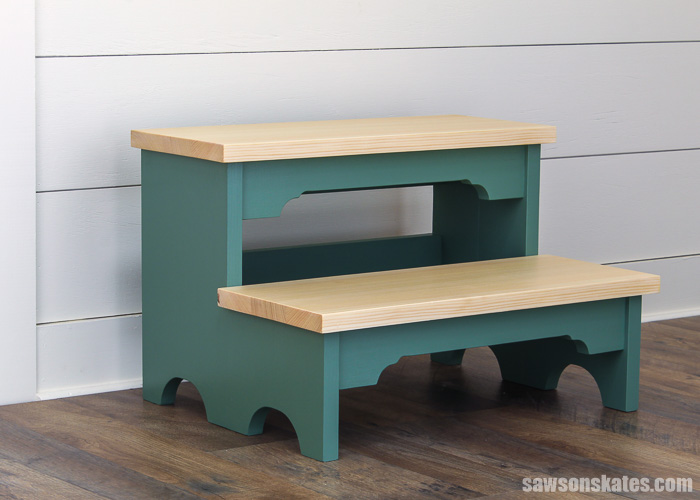
Antique-Inspired DIY Step Stool
This antique-style DIY step stool might remind you of one that you may have seen at your grandparent’s house. Or it might remind you of a stool that you may have seen in a thrift store. That’s because this project was inspired by an old-time step stool.
It’s easy to build and the perfect height to reach those upper kitchen cabinets. It could also be used next to a bed, as stairs for pets or as a plant stand. It features two steps and antique-inspired curved details.
The free plan includes a material list, all of the measurements, detailed instructions, and two templates to layout the curved details. Get the free plan now and build one today.
You may also enjoy this Farmhouse DIY Step Stool and this DIY Ladder Chair.
This tutorial contains affiliate links to supplies and tools. Purchases made using these links help support the Saws on Skates website and allows me to share more projects and tips with you. There is no cost to you for using these links. Visit my site policies for more information.
Before we get into a how to make an antique-inspired DIY step stool, be sure to click the subscribe button at the bottom of this page to sign up for my FREE weekly newsletter loaded with helpful pocket hole tricks, space-saving workshop ideas, clever DIY tips and more!
Table of Contents
- Inspiration for This Project
- Where Can You Use This Step Stool?
- What Tools Do You Need to Make an Antique-Style Step Stool?
- How Do You Attach the Treads?
- What Wood Should You Use?
- How Do You Draw the Curved Details?
- How Do You Finish the Antique-Style Step Stool?
- How to Make an Antique-Inspired Step Stool Tutorial
- Get the Free Printed Plan
Inspiration for This Project
One of my favorite things to do is to recreate antique wood furniture pieces as simple, easy-to-make DIY projects. Antiques were the inspiration for this DIY spice shelf and this DIY display cabinet.
This DIY step stool was also inspired by an antique. It’s not an exact copy of the original but it has similar proportions with two steps and antique-inspired curved details.
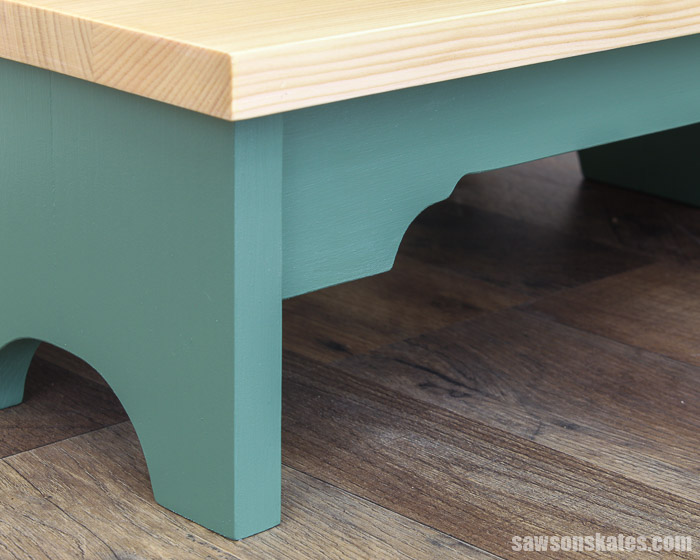
Where Can You Use This Step Stool?
- In the kitchen to reach upper cabinets
- Bathroom
- Next to a bed
- Kids step stool
- As pet stairs
- As a plant stand
- Anywhere you need a little extra height
What Tools Do You Need to Make an Antique-Style Step Stool?
This small DIY step stool is easy to make for DIYers of any skill level. It’s a simple woodworking project that you can make in a weekend using basic skills and just a few common tools.
Tools like a miter saw, pocket hole jig, and a drill. We’ll also need a saw to cut the curved details on the bottom of the sides and the front rails.
Miter Saw
I used a miter saw to cut all of the parts to length for this project.
Related: 7 Miter Saw Tricks Every DIYer Should Know
Pocket Hole Jig
We can use any pocket hole jig to drill the pocket holes for this project. I used the Kreg Jig 720PRO to make the pocket hole joints for my step stool. The inexpensive, user-friendly Kreg Jig 320 is also a great choice for drilling pocket hole joints.
Related: 9 Pocket Hole Mistakes You Don’t Want to Make
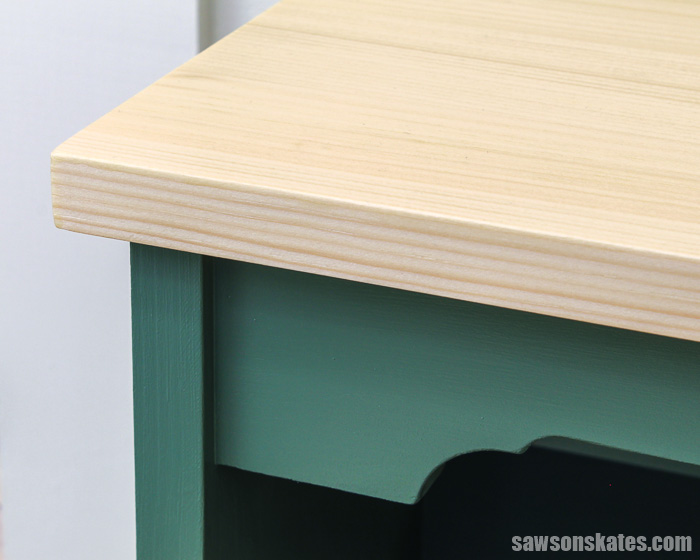
Drill
The drill was used to drill the pocket holes and to drive the screws that join the parts together.
Related: Impact Driver vs Drill: What’s the Difference?
Additional Saw
I used a scroll saw to cut the curved details at the bottom of the sides and the front rail, but you might also be able to make these cuts with a jigsaw instead.
Back to Table of ContentsHow Do You Attach the Treads?
Many times we’ll want to attach a table top to a base with table top fasteners.
The table top fasteners allow for wood movement caused by seasonal changes. If we don’t allow for wood movement the table top could crack.
In many cases, I recommend not using pocket hole screws to attach a table top. Instead, I recommend attaching a table top with table top fasteners that allow for wood movement.
Related: How to Attach a Table Top to a Base (The Right Way)
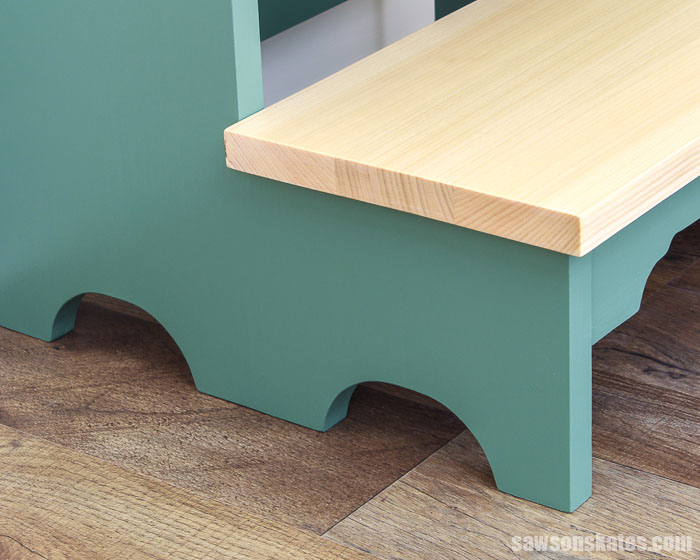
The treads on this step stool project are an exception.
The reason is, the wood grain of the treads and the sides are oriented in the same direction.
Wood expands the most across its width.
The treads and sides will expand across their width or from front to back of this piece. There are no fasteners or cross members that will prevent this movement. This should reduce the chances of the wood cracking or splitting.
Related: Mistakes with Wood Can Cause Your DIY Furniture to Crack
Back to Table of ContentsWhat Wood Should You Use?
This simple step stool can be made with just about any type of wood. I used common pine to build mine. Pine is relatively inexpensive and easy to work with.
I purchased the pine 1×3s and 1×4s at my local home improvement store.
Related: Beginner’s Guide to Wood Sizes
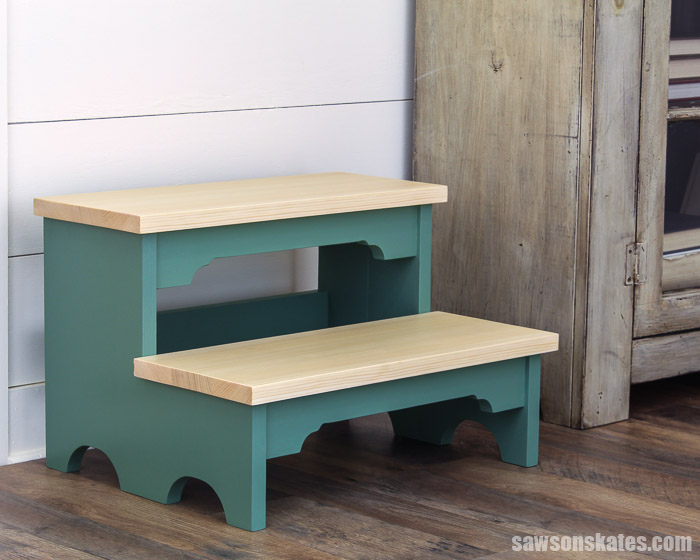
How Do You Draw the Curved Details?
The curves on this step stool could be tricky to draw by hand. Fortunately, you don’t have to. The free printable plan includes two templates that take the guesswork out of laying out these curved details.
Just get the free plan, print the templates, trace them on the boards, and then use a saw to make the cuts.
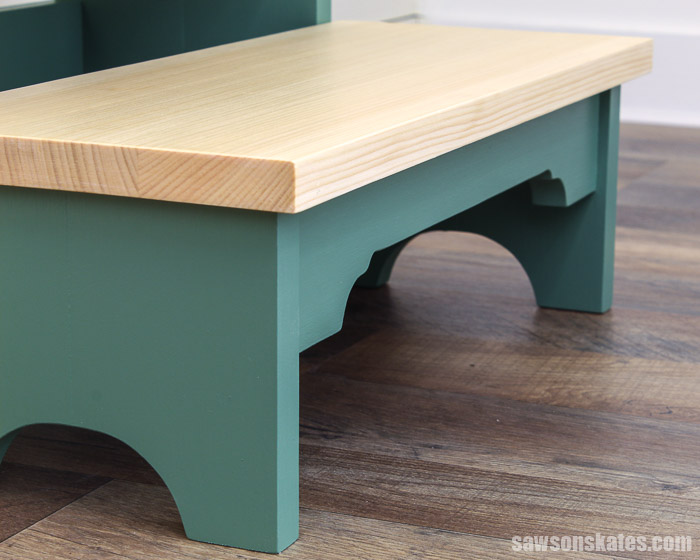
How Do You Finish the Antique-Style Step Stool?
This stool could be finished in a variety of ways. It could be left natural, painted, stained, or a combination of paint and stain.
I planned to paint my steps and apply a clear coat on the treads. I usually apply several coats of this shellac-based primer to prevent any knots from bleeding through the paint.
Related: How to Stop Knots from Bleeding Through Paint
I wanted an aged look for this project, so I wasn’t concerned if any of the knots were to bleed through the paint. Instead, I applied several coats of a Behr color called “Gazebo Green” directly to the wood.
Then, I applied three coats of this natural polyurethane on the treads.
Related: Why I Switched to This Polyurethane Alternative
Back to Table of ContentsAntique-Inspired DIY Step Stool Plan
Printed Plan
- Click here to get your FREE plan (includes detailed instructions, measurements, and bonus tips)
Supplies
- Wood (per printed plan)
- 1-¼” Pocket Screws
- 1-½” Pocket Screws
- Wood Glue
Tools
- Tape Measure
- Drill
- Kreg Jig
- Miter Saw
- Scroll Saw or Jigsaw
- Portable Spindle Sander (optional)
Step 1. Make the Sides
Cut 8 pieces of wood to length. Apply wood glue, and clamp to form 2 side panels.

Then, use the diagram in the printed plan to drill pocket holes in the top of the sides.
Related: How to use a Kreg Jig
📝 NOTE: Depending on which pocket hole jig you have, you might not be able to position your jig to drill the inside pocket hole on the bottom step when the side panel is glued together. In this case, make the side in two steps. Glue the bottom step together and the top step together. When the glue is dry, drill the pocket holes. Then, glue the front step to the back step.
Print the template at the end of the printed plan and use scissors to cut it out.
💡 TIP: When printing the PDF template, be sure to set the scale to 100%.
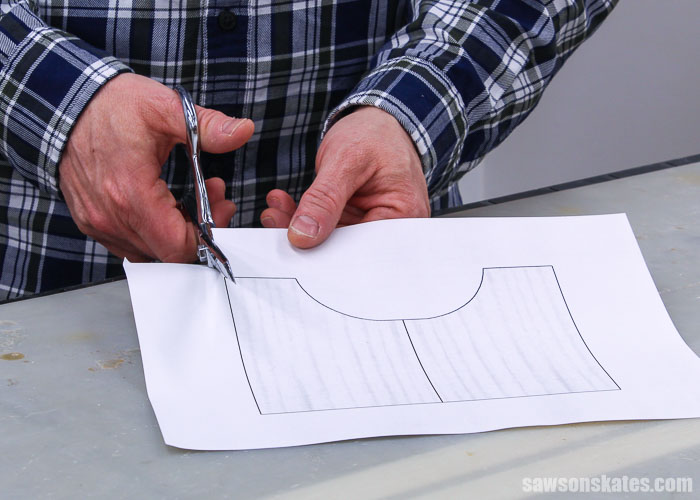
First, I traced the template on the front step.
Then, I moved the template and traced it onto the back step.
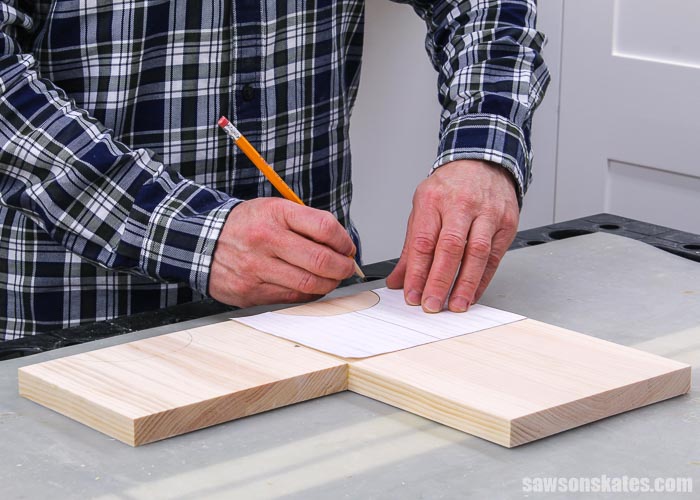
I used a scroll saw with this 10 TPI blade (teeth per inch) to cut out these curved details, but you might be able to use a jigsaw instead.
I made the cuts next to the pencil line. This way, I could sand to the pencil line.
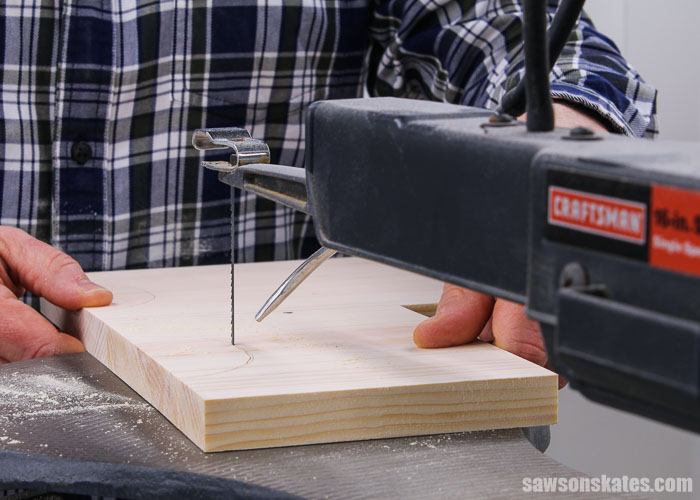
It’s not necessary, but I used this portable spindle sander to smooth the curved edges of the side panels. The spindle sander makes quick work of smoothing any saw marks. If I didn’t have a spindle sander, I would have smoothed the edges by hand with sandpaper.
Related: 11 Secrets for Sanding Wood Projects Like a Pro
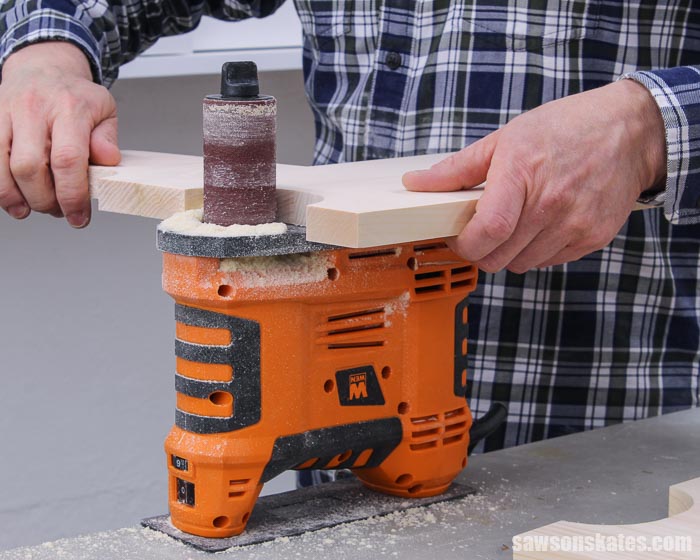
Step 2. Attach the Rails
Cut 4 pieces of wood to length and drill pocket holes in each end.
Print the template at the end of the printed plan. I used a straightedge to align the two sides of the template and used tape to join them together.
💡 TIP: When printing the PDF template, be sure to set the scale to 100%.
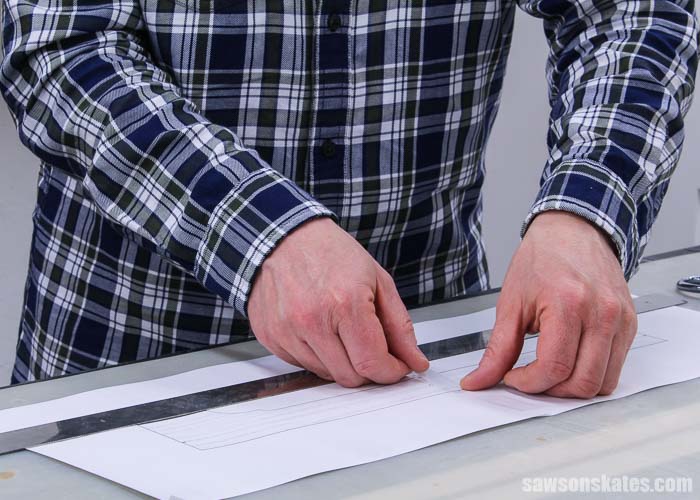
Trace the template on 2 of the rails. I used a scroll saw with this 10 TPI blade (teeth per inch) to cut out these curved details, but you might be able to use a jigsaw instead.
I made the cuts next to the pencil line. This way, I could sand to the pencil line.
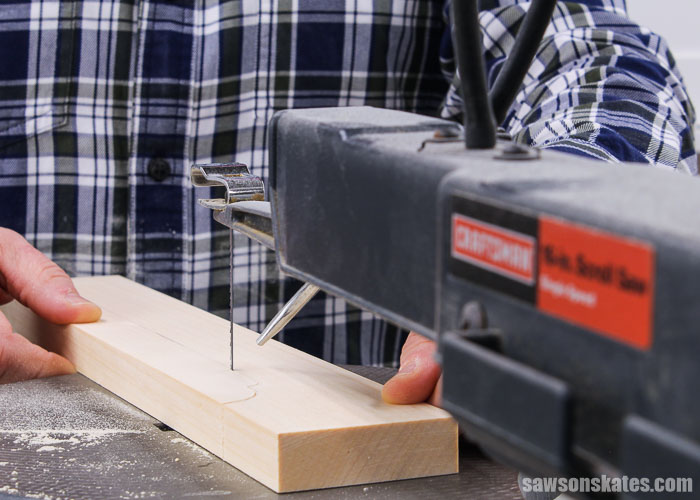
It’s not necessary, but I used this portable spindle sander to smooth the curved edges of the rails. The spindle sander makes quick work of smoothing any saw marks. If I didn’t have a spindle sander, I would have smoothed the edges by hand with sandpaper.
Apply wood glue to the ends of the back rails, position on the sides, and clamp. Attach using 1-¼” pocket hole screws.
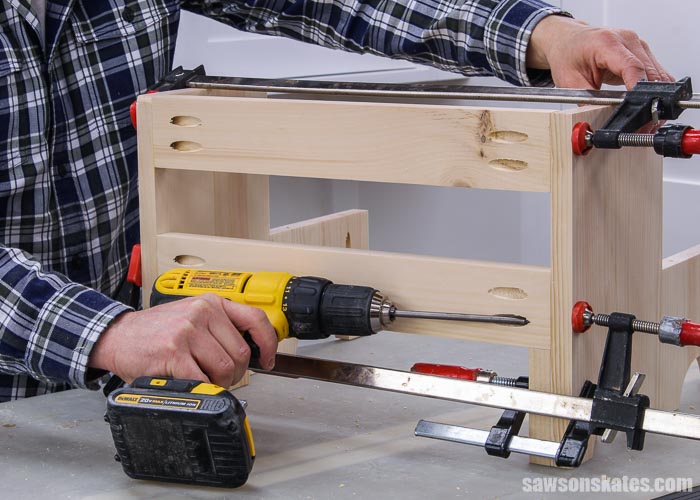
The front rails are set in a ¼” from the front of the steps. To help with the spacing, I temporarily attached pieces of ¼” MDF to the front of the rails with painter’s tape. Apply wood glue to the ends of the front rails. Then position the rail so that the MDF is flush with the front of the step and the top of the rail is flush with the top of the step.
Apply wood glue to the ends of the front rails, position on the sides, and clamp. Attach using 1-¼” pocket hole screws.
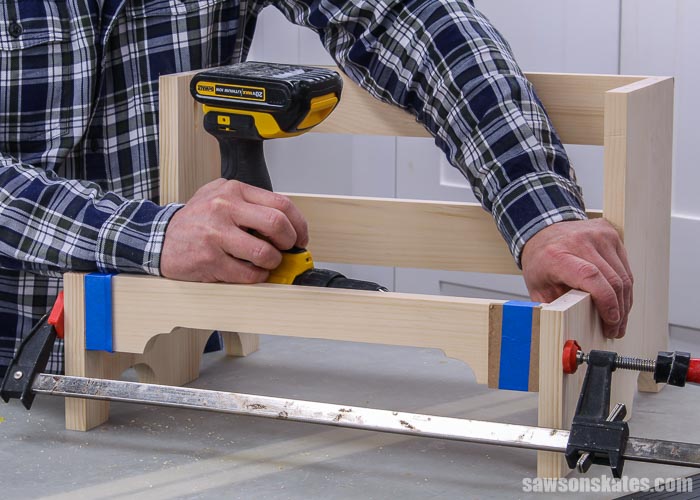
Step 3. Attach the Treads
Cut 6 pieces of wood to length. Apply wood glue and clamp to make 2 treads.
When the glue is dry, center on the steps, and clamp. Attach using 1-¼” pocket hole screws.
Back to Table of ContentsStep 4. Finish the Step Stool
See How Do You Finish the Antique-Style Step Stool? for more information.
Final Thoughts
This DIY step stool with antique-inspired curved details is the perfect way to reach those upper kitchen cabinets. It could also be used next to a bed, as stairs for pets or to display plants.
Click here to get the free plan (including the detailed instructions and measurements) now!
Thank you for stopping by. If you enjoyed this tutorial, would you please take a moment and pin it to Pinterest? I’d really appreciate it!

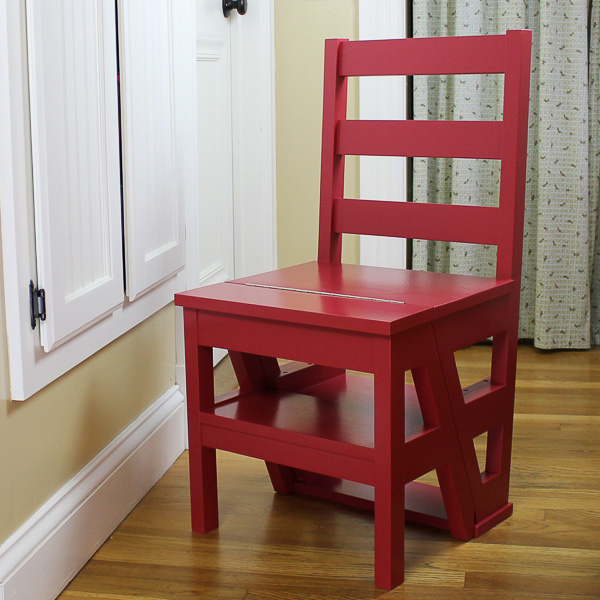
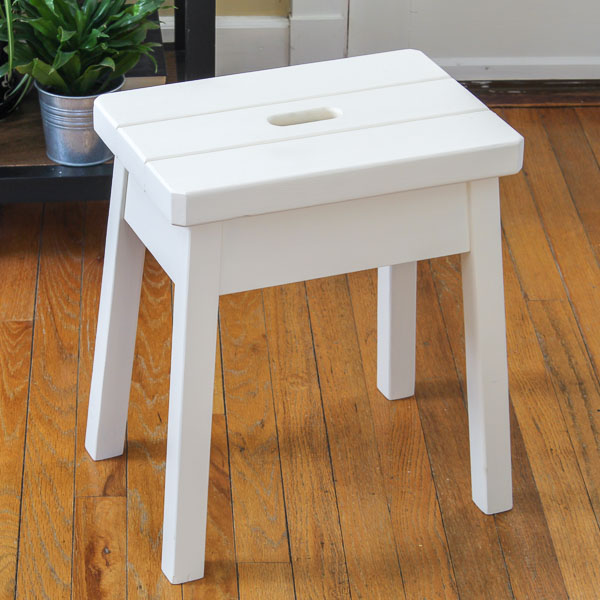
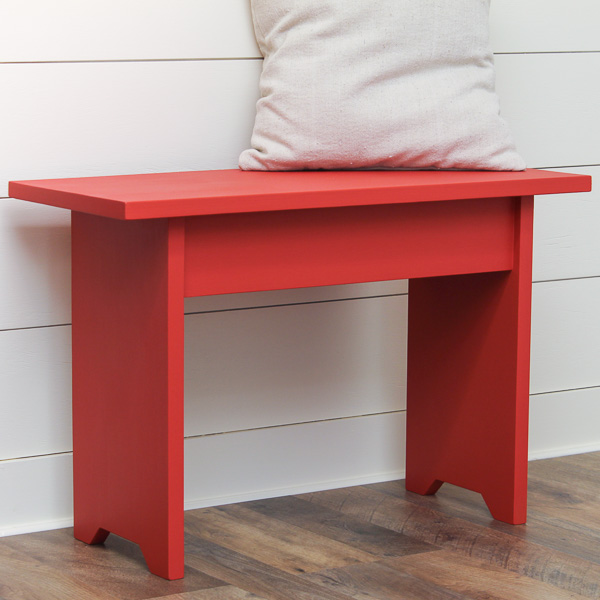
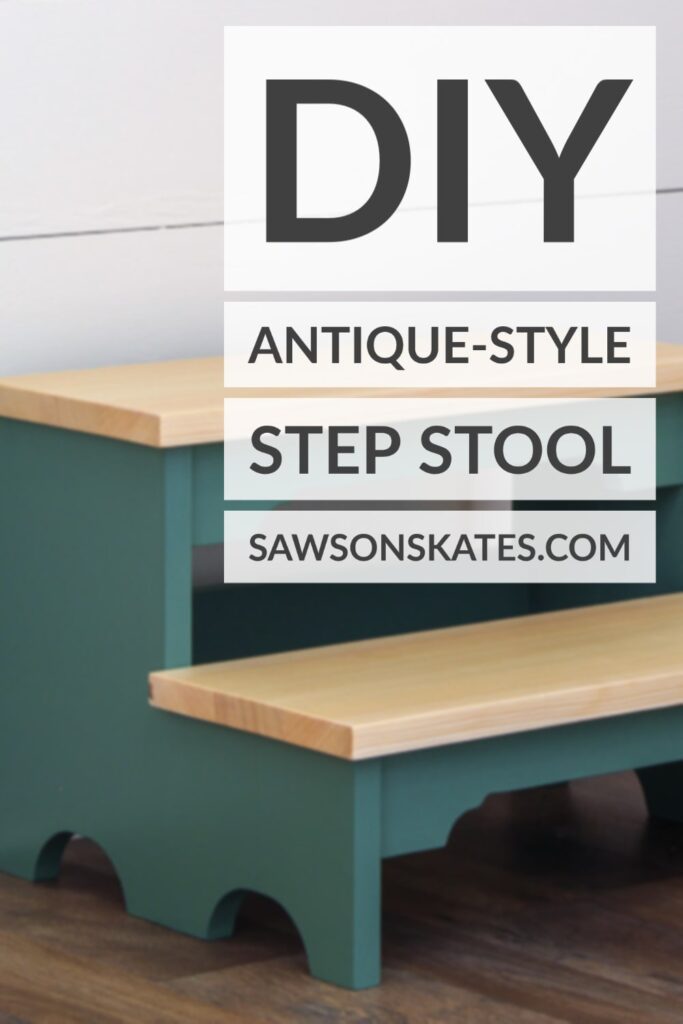
Really like the Step Stool, can’t wait to build it
This plan is awesome. I had fun making this stool and it turned out great. Thanks Scott!
I’m looking forward to doing the next project.
Thanks again,
Christie Lewandowski